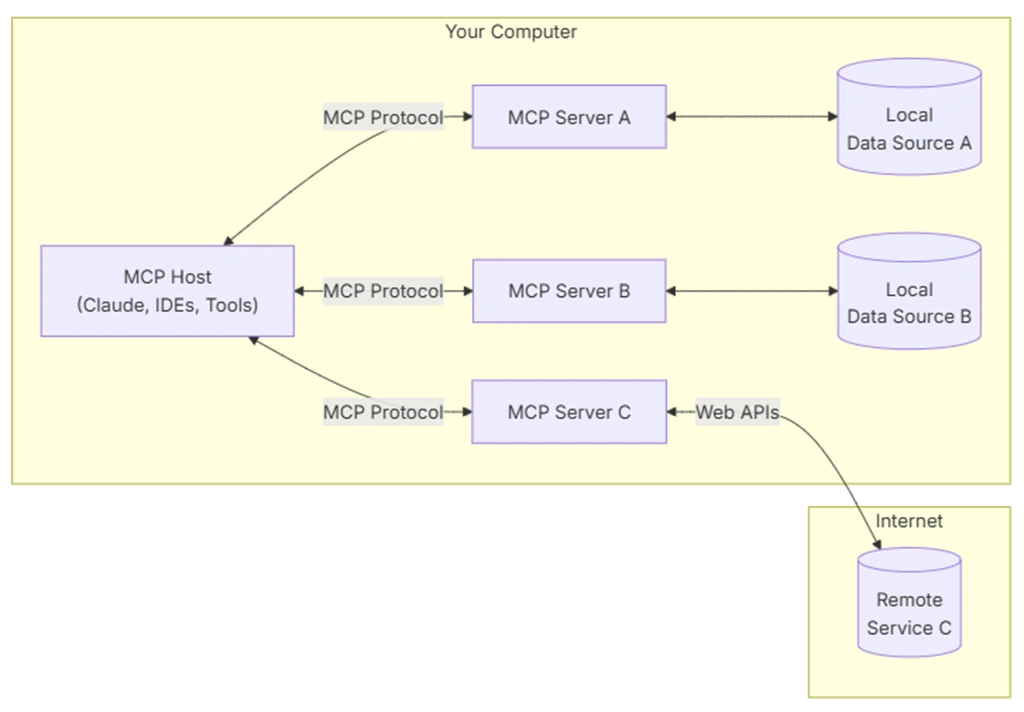26 Aug Building the First AI-Enabled Open Source HCM
Building the First AI-Enabled Open Source HCM: What We Have Done And The Roadmap Ahead
The HR tech landscape is ripe for disruption, and we’re not just talking about another SaaS platform with a chatbot slapped on top.
At MintHCM, we’re building something fundamentally different: the first truly AI-enabled, open-source Human Capital Management solution.
Here’s how we’re doing it, and why it matters for developers who care about the future of recruitment and employee experience.
The MCP Revolution: A New API for the LLM Era
Remember when REST APIs changed everything? Right now, we’re witnessing a similar moment with the Model Context Protocol (MCP).
Instead of forcing AI models to work with legacy APIs designed for humans, MCP creates a native communication layer between LLMs and other applications.

Our Mint MCP implementation turns MintHCM into an MCP server, enabling seamless integration with AI clients like Visual Studio Code, GitHub Copilot Chat and custom LLM applications. Think of it as GraphQL for AI agents – structured, efficient, and designed for machine consumption.
The beauty lies in the architecture: your AI tools can directly query employee data, create calendar entries, or pull recruitment metrics without the typical API wrestling match. Set up a domain pointing to your /mcp directory, configure OAuth 2.1 authentication, and suddenly your development environment becomes AI-supercharged.
Your AI assistant can now natively understand queries like:
“Show me all developers hired in Q4 with their onboarding status”
Instead of you writing API calls and parsing responses.
AI Agent: HR Assistant You Were Looking To Hire
Most “AI-powered” HR tools are glorified search interfaces. Our AI Agent is different – it’s a true autonomous assistant that can perform actions, not just answer questions.
Built on LangGraph architecture, the agent features specialized nodes that handle everything from conversation memory to tool execution. The gear_manager_node initializes conversations with context-aware prompts, while the tool_controller_node adds a security layer before actions are executed.
What sets it apart? Human-in-the-loop by design. The agent will ask
“Should I schedule this interview with the candidate for tomorrow at 2 PM?”
instead of silently creating calendar chaos. It’s automation with guardrails – exactly what any business software need.
The modular design means you’re not locked into OpenAI or any single provider. Swap in Claude, Gemini, ChatGPT or your self-hosted model without touching the core logic. Open source AI should mean open choices.
AI by Design: Rethinking Mint’s Data Architecture
Here’s where things get interesting from a systems design perspective. Most software adds AI as an afterthought, resulting in clunky integrations and disappointed users. We’re taking the opposite approach and call it: “AI by design”.
Just so you know, we’re actively restructuring MintHCM’s data model to be LLM-friendly. This means:
- Semantic field naming: Instead of cryptic database columns like
emp_stat_cd, we useemployment_statusthat LLMs can understand contextually - Relationship clarity: Foreign keys and table relationships are documented in ways that AI models can traverse naturally
- Embedded context: Critical business logic is embedded as metadata that AI agents can access during decision-making
Think of it as designing your database schema for both SQL queries and natural language understanding simultaneously. It’s more work upfront, but it pays dividends when your AI agent actually understands your data model without extensive prompt engineering.
AI-Powered Development
We’re not just building AI features – we’re using AI to do so. Our development process leverages newly available technology at every stage:
- Code Generation: GitHub Copilot isn’t just autocomplete anymore; it’s a pair programming partner that understands our codebase patterns and suggests contextually relevant solutions. We use it religiously while creating new lines of our own minty-fresh code.
- Testing: At MintHCM we also use AI-generated test cases based on user stories and edge case analysis. The models identify potential failure points that human developers might miss, creating more robust software. Of course, alongside human testing. Shoutout: @JoannaZ’s team!
- Documentation: Instead of developers writing docs (and inevitably falling behind), our AI systems generate comprehensive documentation directly from code comments, API endpoints, and test cases. The docs stay current because they’re regenerated with each release. Just please stay with us until we catch up with all the previously made features’ documentation.
- Internationalization (i18n): Manual translation is dead (or hanging by a thread). Our AI solution automatically translates the entire system interface using context-aware models that understand HR terminology across languages. Therefore, new language support becomes a configuration change, not a months-long project. If you’re looking to use MintHCM in Arabic or Chinese, check our AI-generated, human-reviewed translations on CrowdIn.

New AI Features In The Works
Forget AI buzzword bingo – our AI features solve real problems developers and HR teams face daily. Here are just a couple of ideas we have for the upcoming releases:
- Intelligent Job Description Generation: Point the system at a role’s requirements and team context, and get back a job description that doesn’t sound like corporate buzzword soup. The AI understands your company culture from existing data and generates descriptions that actually attract the right candidates.
- Dynamic Interview Questions: Based on the candidate’s background and role requirements, the system generates purposeful interview questions. No more generic “tell me about yourself” – it’s about time HR teams started to ask on-target questions that reveal actual fit and capability.
- Smart Offboarding Insights: Instead of standard exit interview forms, the AI crafts personalized workflow based on the employee’s tenure, role, and team dynamics. More importantly, it analyzes responses across all exit interviews to identify systemic issues before they become bigger problems.
- Portal Content Optimization: Your job postings get AI-generated variations optimized for different job boards and audiences. Same role, different messaging for LinkedIn, Stack Overflow Jobs, Indeed or Upwork.

The Advantage Of “Open Source + AI” Approach
Have you ever wondered why using Open Source and AI matters for the developer community and HR teams out there?
Obviously, every innovation we build as an open source project becomes available to fork, modify, and improve. No vendor lock-in, no feature gates, no “contact sales for enterprise AI.”
But nowadays, the implications of going for open source solutions are even greater. Thanks to AI a startup can deploy the same capabilities as enterprise HR departments. Consultants and citizen developers can build custom AI features for specific industries, without waiting for new releases or going for costly development. Researchers can experiment with new HR automation approaches without starting from scratch.
Most importantly, the community can audit the AI decision-making process. When an AI agent suggests a candidate or flags a performance issue, you can examine exactly how that decision was made.
Remember: Transparency isn’t just good practice. It’s essential when AI impacts people’s careers.
What’s Next? For MintHCM And in General
We’re just getting started. The new MintHCM’s roadmap includes: predictive analytics that actually predict useful things, automated compliance checking that adapts to regulatory changes, and AI-driven organizational design recommendations based on team dynamics and business goals.
But the real future lies in the ecosystem effect. When HR systems speak native AI protocols, when data models are designed for machine understanding, and when the entire stack is open and extensible – that’s when we’ll see truly transformative AI applications emerge.
AI-enabled open source HCM isn’t just about better HR software. It’s about establishing the infrastructure for a new generation of workplace AI that serves humans rather than vendor profit margins.
Are you ready to enter the future of Human Capital Management?

